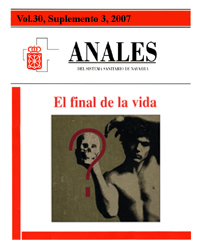La muerte clínica: un diagnóstico y un testimonio
DOI:
https://doi.org/10.23938/ASSN.0202Palabras clave:
Muerte encefálica, Muerte clínica, Diagnóstico, ÉticaResumen
La muerte clínica de una persona es la muerte del encéfalo. Hay un consenso bastante generalizado en nuestra medicina occidental sobre los criterios necesarios y el modo de proceder para un correcto diagnóstico de “muerte encefálica”. En un caso concreto, cuando existen antecedentes razonables de daño cerebral catastrófico y determinados signos clínicos en la exploración neurológica, un médico con suficiente experiencia puede llegar a emitir un diagnóstico de muerte clínica. Aceptando que el diagnóstico de muerte es un ejercicio de puro juicio práctico, y que como tal nunca puede dar certidumbre absoluta, debemos asumir que a pesar de la incertidumbre debemos tomar decisiones razonables y prudentes. Sin embargo, existen opiniones discrepantes que consideran sería necesario un más alto grado de certeza antes de tomar decisiones. Para tomar decisiones responsables se requiere intentar comprender el concepto de la muerte cerebral como un auténtico constructo cultural en el que son necesarios conocimientos a cerca de “qué” es lo que se define científicamente como muerte; el “cómo” se puede diagnosticar en la práctica; el “cuándo” se dice que un hombre está clínicamente muerto, y de “cual” es el grado de evidencia que conlleva el diagnóstico.Descargas
Descargas
Publicado
Cómo citar
Número
Sección
Licencia
La revista Anales del Sistema Sanitario de Navarra es publicada por el Departamento de Salud del Gobierno de Navarra (España), quien conserva los derechos patrimoniales (copyright ) sobre el artículo publicado y favorece y permite la difusión del mismo bajo licencia Creative Commons Reconocimiento-CompartirIgual 4.0 Internacional (CC BY-SA 4.0). Esta licencia permite copiar, usar, difundir, transmitir y exponer públicamente el artículo, siempre que siempre que se cite la autoría y la publicación inicial en Anales del Sistema Sanitario de Navarra, y se distinga la existencia de esta licencia de uso.








